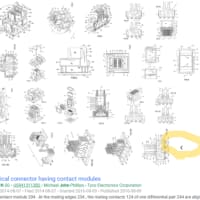US10049780(JP, Mitsubishi)
"However, in case of the polymer suspension coating method, it is difficult for a dispersion of an electroconductive polymer to impregnate in the inside of a dielectric layer. As a result, a solid electrolyte layer is not easily formed in the inside of the fine irregularities (pores) of a dielectric layer and it is formed only on a surface layer. Thus, there is a problem that the electric capacitance exhibition rate of the obtained solid electrolyte condenser is low. "
しかし、ポリマー懸濁液塗布法の場合、導電性ポリマーの分散液が誘電体層の内部まで含浸しにくかった。その結果、誘電体層の微細な凹凸の内部(細孔)には固体電解質層が形成されにくく、表層のみに固体電解質層が形成されるため、得られる固体電解コンデンサの電気容量発現率が低くなるという問題があった。
EP3361537(JP, Sekisui)
"[0149] With regard to the lithium ion secondary batteries obtained in the above Examples and Comparative Examples, constant current constant voltage charge of 0.2 C at 25°C was performed until a current value converged to 0.1 C with an upper limit voltage of 4.2 V. Thereafter, constant current discharge of 0.2 C was performed up to 2.7 V. Subsequently, the charge and discharge cycle was repeated a plurality of times at a charge and discharge current of 1 C in a similar manner to stabilize a state of each of the lithium ion secondary batteries. Subsequently, the charge and discharge cycle was repeated at a charge and discharge current of 1 C in a similar manner, and a capacity development ratio ({[discharge capacity at first cycle (mAh)]/[rated capacity (mAh)]} × 100) (%) and a capacity retention ratio at 100th cycle ({[discharge capacity at 100th cycle (mAh)]/[discharge capacity at first cycle (mAh)]} × 100) (%) were calculated. Note that the rated capacity (theoretical capacity) of each of the secondary batteries was 4 mAh. Evaluation results of the secondary batteries are written in Tables 1 and 2."
上記各実施例及び比較例で得られたリチウムイオン二次電池について、25℃において0.2Cの定電流定電圧充電を、上限電圧4.2Vとして電流値が0.1Cに収束するまで行った後、0.2Cの定電流放電を2.7Vまで行った。次いで、充放電電流を1Cとして同様の方法で、充放電サイクルを複数回繰り返し、リチウムイオン二次電池の状態を安定させた。次いで、充放電電流を1Cとして同様の方法で、充放電サイクルを繰り返し、容量発現率({[1サイクル目の放電容量(mAh)]/[定格容量(mAh)]}×100)(%)、及び100サイクルでの容量維持率({[100サイクル目の放電容量(mAh)]/[1サイクル目の放電容量(mAh)]}×100)(%)を算出した。なお、各二次電池の定格容量(理論容量)は、4mAhであった。各二次電池の評価結果を表1及び表2に示す。
US10305143(JP, Toray)
"A 9 μm-thick polyethylene (PE) separator E09HMS (manufactured by Toray Battery Separator Film Co., Ltd.) was used to prepare a battery cell having a cell structure of positive electrode/PE separator/polymer-ion-permeable membrane sample/PE separator/negative electrode. The prepared battery cell was similarly evaluated, and the result showed that the battery had a capacity achievement ratio of 98% in finishing charge-discharge, and a power characteristic of 95% at 0.5 C, 86% at 1 C and 68% at 3 C. Thus, the capacity achievement ratio at a high rate was improved as compared to the polymer-ion-permeable membrane alone. "
さらに、厚み9μmのポリエチレン(PE)セパレータE09HMS(東レバッテリーセパレータフィルム社製)を用い、セル構成を、正極/PEセパレータ/ポリマーイオン透過膜の試料/PEセパレータ/負極として電池セルを作製した。作製した電池セルについて同様に評価を実施した結果、仕上充放電の容量発現率が98%、出力特性は0.5Cで95%、1Cで86%、3Cで68%と、単独の場合に比べ、高レートにおける容量発現率が向上した。
EP3147975(JP, Nippon Chem. Con.)
"[0037] With a C.C. mode (constant current mode) set in which the discharge rate is 1 C and the working voltage of this cell is from 2.5 V to 4.3 V, the charging/discharging characteristic was examined. The C rate was calculated using a theoretical capacity of 117.9 mAhgFig. 9 is a graph showing the charging/discharging characteristic of the cathode material including the lithium vanadium phosphate with aluminum as a solid solution. In Fig. 9 , the horizontal axis indicates the discharge capacity and the vertical axis indicates the potential. As shown in Fig. 9 , as a result of using the composite body of CNF and the lithium vanadium phosphate with aluminum as a solid solution of the first embodiment example in the electrode material, the charge capacity was 126 mAhg, which is slightly higher than the theoretical capacity 117.9 mAhgcalculated when the theoretical capacity is reduced by an amount corresponding to doping with aluminum, and this indicates a capacity expression rate of 107%. Furthermore, the discharge capacity was 124 mAhgwhich is slightly higher than the theoretical capacity 117.9 mAhgand this indicates a capacity expression rate of 105%. "
このセルを作用電圧2.5〜4.3Vとして、放電レートを1CとするC.Cモード(定電流モード)にて、その充放電特性を調べた。尚、Cレートは、理論容量117.9mAhg−1を用いて計算した。図9は、アルミニウムが固溶したリン酸バナジウムリチウムを含む正極材料の充放電特性を示すグラフである。図9において、横軸は放電容量を示し、縦軸は電位を示す。図9に示すように、実施例1のアルミニウムが固溶したリン酸バナジウムリチウムとCNFの複合体を電極材料に用いた結果、充電容量は、アルミニウムを添加した分だけ理論容量が減るとして算出した理論容量117.9mAhg−1に対し、若干増えて126mAhg−1となり、容量発現率は107%であった。また、放電容量は、理論容量117.9mAhg−1に対し、若干増えて124mAhg−1となり、容量発現率は、105%であった。
最新の画像[もっと見る]
-
 凡例
3日前
凡例
3日前
-
 バズリクソンズA2:第18週
7日前
バズリクソンズA2:第18週
7日前
-
 バズリクソンズA2:第17週
2週間前
バズリクソンズA2:第17週
2週間前
-
 バズリクソンズA2:第16週
3週間前
バズリクソンズA2:第16週
3週間前
-
 DAZN(ダゾーン):メール配信停止ボタンくらい付けとけ
4週間前
DAZN(ダゾーン):メール配信停止ボタンくらい付けとけ
4週間前
-
 DAZN(ダゾーン):メール配信停止ボタンくらい付けとけ
4週間前
DAZN(ダゾーン):メール配信停止ボタンくらい付けとけ
4週間前
-
 バズリクソンズA2:第15週
1ヶ月前
バズリクソンズA2:第15週
1ヶ月前
-
 バズリクソンズA2:第14週
1ヶ月前
バズリクソンズA2:第14週
1ヶ月前
-
 Google Patents Advanced Searchで全部表示される図面の表示を隠す
1ヶ月前
Google Patents Advanced Searchで全部表示される図面の表示を隠す
1ヶ月前
-
 召合せ框(めしあわせかまち)
1ヶ月前
召合せ框(めしあわせかまち)
1ヶ月前

















※コメント投稿者のブログIDはブログ作成者のみに通知されます